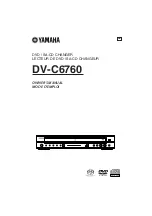
7
1. Pull out the cutterhead lock lever (1) to
unlock the cutterhead. (Fig. 12)
2. Lower the cutterhead until it touches the
workpiece.
3. Set the cutting depth indicating to
“3 mm” mark.
4. Raise the cutterhead a little and remove
the workpiece.
5. Adjust the depth of cut to the desired
finished thickness of the board.
6. Lock the cutterhead.
7. Push in the cutterhead lock lever (1).
(Fig. 13)
8. Start board under the infeed roller so it
travels straight. When infeed roller takes
hold, release board and stand aside (out
of the way of any possible kickback).
9. If the board is long, place it on the top of
the thicknesser and roll it to the front for
replaning.
NOTE:
1. Planing for a smooth finish as well as
thicknesser is best accomplished by
taking light cuts on the board.
2. For the best result, plane both sides
of your workpiece to reach the desired
thicknesser.
●
Remove all foreign objects from the
workpiece. Do not plane wood that is
severely knotted or warped.
●
Remove all foreign objects from the
workpiece. Do not plane wood that is
severely knotted or warped.
●
The thicknesser works best with at
least one flat surface. Place the flat
surface downward on the table.
●
Do not plane more than 3 mm in one
pass.
●
Proper depth of cut is judged by the
width of the board and hardness of
the board.
●
Make sure long boards are supported
level with table at front and rear of
the thicknesser. Use extension roller
stand if necessary.
●
Do not receive the board with your
hands toward inside of the rear
extension table.
3. If snipe happens (snipe is a depression
made when the ends of the workpiece
contact the cutters), make sure the
extension tables and support stands are
level with the main table and the flat side
of the workpiece is against the tables.
4. For bowed workpiece, removing the
bow with a jointer is recommended.
5. For cupped or warped workpieces,
plane the top flat and then turn it over
and plane the bottom flat.
NOTE:
The blades changing accessories
are stored in the tool storage.
CHANGING BLADES (FIG. 14, 15, 16, 17)
1. Rotate the handle to lower down the
cutterhead to 50 mm height.
2. Remove the dust collector.
3. Remove the two screws (1) with a
screwdriver, and then remove the dust
cover (2). (Fig. 14).
4. Press the lock latch (3) and carefully
turn the cutterhead until it exposes eight
hex bolts (4). (Fig. 15)
5. Remove the eight hex bolts (4) with the
supplied wrench. (Fig. 16)
6. Carefully remove the hold-down plate (5)
by lifting straight up. (Fig. 16)
7. Carefully remove the blade (6) by lifting
both ends straight up. (Fig. 16)
8. The blade has two cutting edges. If
using the other side of the blade or
replacing the blade, place the blade
on the cutterhead by locating the two
slotted holes in the blade over the
locating pins on the cutterhead.
9. Slightly adjust the blade position so that
it is positioned uniformly in the center of
the cutterhead.
WARNING! To avoid injury from on
accidental start-up, always turn the
switch off and remove the power plug
from the power source before changing
the blades.
Changing Blades
Summary of Contents for AP3300
Page 1: ...1 GB 13 IN 330 MM BENCH THICKNESSER AP3300 INSTRUCTION MANUAL...
Page 2: ...2 CONTENTS GB P 1 8 The original instruction manual is in English...
Page 14: ...11 Fig 16 Fig 18 Fig 17 Fig 14 4 3 4 6 5 8 7 Fig 15 1 2 1 2...
Page 16: ...13 MODEL AP3300 Schematic A...
Page 18: ...15 Schematic B MODEL AP3300 MANUAL INSTRUCTION...
Page 20: ...17...






































